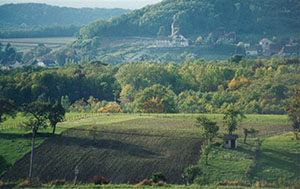


Vines have been cultivated in the Savoy since ancient times, with vines being mentioned by writers such as Pliny from the first century BC. The Savoy vineyard reached its apotheosis in the 19th century, with more than 8,000 hectares, before being reduced to less than 2,000 hectares with the phylloxera crisis. Nowadays, there are around 2,100 hectares.
Nestled between lakes and mountains, the Savoie vineyards are spread on hillsides at between 300 and 600 metres of altitude, from Lake Geneva to Chambéry. The climate is continental, with harsh winters and hot summers. The pebbly, eroded soils are varied, though predominantly chalky. The Savoy is lucky to have a wide variety of grape varieties, which are often indigenous and original such as Jacquère, Roussette (or Altesse), Gringet, Mondeuse, Persan, but also more well-known varieties such as Chardonnay, Roussanne, Chasselas, Pinot noir and Gamay. There are no less than 23 authorised varieties, of which 7 are found only in Savoy (Altesse, Gringet, Molette, Mondeuse noire (a close relative of Syrah), Mondeuse blanche, Persan and Jacquère).
For the most part, the Savoy produces well-reputed white wines, but also red wines, rosés, and sparkling wines. The whites are generally vibrant and light (especially Jacquère), sometimes slightly more unctuous (Roussanne), or complex and refined (Roussette de Savoie), while the reds can be fruity and light (Gamay) or rich, fruity and well-structured (Mondeuse, Persan). Savoy wines are particularly recommended to go with cheeses (Abondance, Beaufort, Emmental, Reblochon, Tomme), but also to go with charcuterie (Mondeuse). There are currently three appellations in the region: vin de Savoie, Roussette de Savoie and Seyssel. A fourth appellation is in the process of being created, for crémant de Savoie.
Recognised as an appellation since 1973, the Savoie PDO is spread over 1,800 hectares and covers all Savoie vineyards, in Haute-Savoie, Ain and Isère. The appellation Vin de Savoie can be completed with any of the following 16 geographical denominations: Abymes (whites), Apremont (whites), Arbin (reds), Ayze (whites, semi-sparkling and sparkling), Chautagne (whites and red), Chignin (whites and reds), Chignin-Bergeron (whites), Crépy (whites), Cruet (whites), Jongieux (whites and reds), Marignan (whites), Marin (whites), Montmélian (whites), Ripaille (whites), Saint-jean-de-la-porte (reds), Saint-jeoire-prieuré (whites).
The appellation Roussette de Savoie has been recognised since 1973 and is spread over around 50 hectares. It can be followed by any of the four following geographical designations: Frangy, Monthoux, Marestel, Monterminod. As the name suggests, it is limited to the Roussette (or Altesse) variety. Chardonnay or Mondeuse can be added to these whites, but the crus must be produced using solely Roussette. The result is a dry white wine, with aromas of honey and almond, which is particularly unctuous, elegant and very refined.
Lastly, there is also the Seyssel PDO, where white wines made from Roussette and sparkling wines of Molette and Roussette are produced. The appellation is made up of around 80 hectares. The wine which is produced there is characterized by its aromas of white fruits and flowers (violet, iris and bergamot), and on the palate it is both delicate and full-bodied, well-balanced between freshness and roundness. The sparkling wines give off citrus fruit and yellow fruit (apricot, peach) aromas, as well as a lovely sweetness on the palate.
Savoie